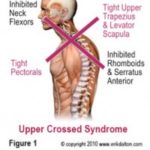
Forward Head & Rounded Shoulders
According to researchers every inch the head moves forward of the shoulders, weight is elevated by 10 pounds. As a result, a 12 pound head held 3 inches forward, forces the cervical extensors (semispinalis, splenii, longissimus, upper traps, etc.) to isometrically hold up 42 pounds against the unrelenting force of gravity. And we are amazed that so many clients present with degenerative disc disease, head pain and TMJ.
Forward Head Postures such as the Upper Crossed Syndrome are the result of poor sleeping positions, driving stress, computer neck, whiplash, and faulty breathing habits. Pain becomes apparent due to muscle strain, disc herniations, arthritis, pinched nerves and overstretching of the spinal cord. A significant part of head, neck, jaw and shoulder pain is due to poor posture, tension, trauma, and central nervous system malregulation. These symptoms may reveal as fibromyalgia, myofascial tender points, TMJ, and chronic fatigue syndromes.
The following traits typically accompany this Upper Crossed strain pattern:
- Suboccipital pain syndromes
- Sleep apnea and mouth breathing
- Problems with swallowing
- Clenching of Teeth
- Pain in the face and neck
- Migraine headache pain
The increased pressure imposed on the neck from the altered posture flattens the normal curve of the cervical spine resulting in abnormal strain of muscles, ligaments, fascia and bones. As reported in the respected Spine Journal, 2006; 6:591-694,forward head carriage causes increased aging of intervertebral joints resulting in degenerative disc disease (cervical osteoarthritis) and osteoporosis.
The repercussions of poor posture go far beyond just looking awkward. According to the January, 2006 issue of the American Journal of Pain Management, posture and function are related. Bad posture is often very noticable in clients with chronic pain-related conditions including low back pain, neck related headaches, and stress-related illnesses.
Posture affects and modulates every role in the body from breathing to hormonal production. Spinal pain, headache, mood, blood pressure, pulse and lung capacity are among the functions most easily impacted by poor posture. According to the Mayo Clinic Health Letter Vol. 18, #3, March 2000, the results of long term forward neck posture lead to “myospasm, disc herniations, osteoporosis and pinched nerves.”
When spinal tissues are exposed to prolonged compression, they deform and go through a transformation that can become permanent. Correction of Upper Crossed neck posture is key to halting and reversing decay and degenerative disc disease and pain from headaches, rib dysfunction, TMJ, and Dowager’s Humps. But, it can be helped over time with a concerted effort using modalities such as Myoskeletal Alignment(R), AIS Stretching & Strengthening and Therapeutic Massage to repair the damage caused by faulty forward head posture.
The Problem: Flexion Addiction
Still, a frustrating question remains: Why do so many clients present with this upper crossed pattern? The answer is, to me, painfully obvious: flexion addiction.
The last century has witnessed a dramatic acceleration in our culture’s flexion addiction. This pervasive and insidious condition is primarily due to the population’s generational transition from an active group of movers to a sedentary bunch of sitters. Researchers estimate that up to 75 percent of chronic neck/back pain clients will present with this or lower crossed patterns.
Recent Posts
- Arthritis?
- 5 Tips for Active Aging
- What is NeuroKinetic Therapy?
- Active Isolated Stretching (AIS) with Aaron Mattes – YouTube
- 50% of Office Workers have Shoulder & Neck Pain
- Forward Head and Rounded Shoulders
- Postural & Muscle Imbalance
- Sway Back, Lumbar Lordosis & Pelvic Tilt
- Benefits of Kinesio Taping
- Active Isolated Stretching for Runners
- The Pain Facts
Keith Caskey
- 8770 Guion Rd., Suite L Indianapolis, IN 46268
- 317.997.7416
- [email protected]
- Google Map
- Contact Form
